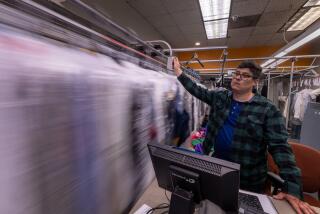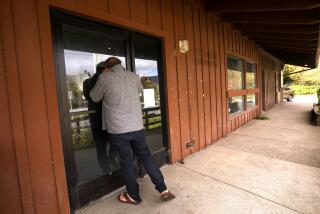Mail Bonding: Neighbors Hate to See Blue Boxes Go
For generations, the blue mailbox on the corner of Bomberry Street and Clubhouse Drive was a meeting place where neighbors caught up while walking the dog or pushing the baby stroller.
Then, one day this summer, it vanished.
Postal officials determined that the mailbox, along with 17 others in Lakewood, was not being used enough and should be removed.
To residents, it was like losing a trusted neighbor.
“It was more than just a convenient place to drop off your mail,” said Larry Benarth, who lives a few houses from the corner. “It was a gathering point.”
The people of Clubhouse Drive decided to fight for their mailbox -- and they’re not alone.
Across the nation, the U.S. Postal Service’s familiar blue boxes have been disappearing from neighborhood street corners as more people look to the Internet to stay in touch and pay their bills.
The post office has reduced 42,000 boxes to scrap metal since 1999. About 295,050 boxes remained standing as of 2005.
The Sept. 11 terrorist attacks accelerated the removals. Officials took out scores of boxes around landmarks like the U.S. Capitol out of concern that explosive devices could be placed inside them.
But in most of the areas that have had boxes removed, the issue was less about homeland security than lack of use.
Several communities in Northern and Central California have been particularly hard-hit. San Leandro’s postmaster announced in May that she planned to remove 30 of the city’s 103 collection boxes, mostly from smaller neighborhoods. More than a third of the boxes in Salinas were removed after a routine collection survey. San Jose has lost more than a third of its boxes since 2000.
In Lakewood, the boxes simply became too expensive to maintain for so little business, Post Officer-In-Charge Steve Ham said.
Not only do mail collectors have to make fruitless trips to underused boxes, but they must also deal with graffiti and random objects dropped inside, he said.
“Our guys find soda pop dumped into them, liquor bottles, firecrackers, animal feces, cherry bombs,” Ham said. “We’re constantly having maintenance go around and clean graffiti.”
Collections surveys found that removing the boxes in Lakewood would result in fewer than 25 pieces of mail a day having to be posted elsewhere.
“We’re not just going to leave them sitting out there if we’re not picking up any mail from them,” Ham said.
Postal officials blame the declining use of mailboxes not only on e-mail but on changes in customer behavior. Officials said people have increasingly dropped off their mail at drive-through areas at post offices or at shopping centers.
First-class mail deliveries by the Postal Service have declined 20% since 1998.
The removals have sparked backlashes in neighborhoods around the country.
In Oakland, residents three years ago collected 200 signatures on a petition to have two mailboxes returned, including one that had served their neighborhood since the 1950s. The Postal Service eventually reinstalled the boxes.
“Mailbox preservation” efforts have also been mounted in New Jersey, Florida, Oklahoma and elsewhere. The debate has been most intense in areas with large numbers of senior citizens, who say they have trouble traveling farther to drop off mail.
Clubhouse Drive in Lakewood is a middle-class family neighborhood a few blocks from the Lakewood Country Club. When Clubhouse lost its mailbox, residents started dropping off their mail at the local post office or at work. Others walked a few blocks to another mailbox.
At a block party a few days after the removal, residents joked about erecting a shrine to the mailbox or even building a replica. But in the end, they vowed to fight to get their box back.
Several people repeatedly called Lakewood City Hall to demand help. Others petitioned the post office.
Then, a few days later, Kim Neipling, who had helped spearhead the effort, got a call from a neighbor.
“He said he thought he did a pretty good job of replicating the box,” Neipling said.
She rushed outside her home to take a look.
It was no replica.
The post office had returned a mailbox to the corner of Bomberry and Clubhouse.
Upon close inspection, Neipling realized it was the same box officials had removed days earlier, complete with the etchings neighborhood kids had left over the years.
Postal officials insist the blue mailbox won’t become a relic.
But it’s already become a museum piece.
The Smithsonian’s National Postal Museum obtained two of the blue boxes for its collection and put them on display last year.
“It is the standard of mail delivery that we needed to keep in the museum for future generations to remember,” said Nancy Pope, museum curator and historian. “The box is the best icon you can have to represent mail -- second only to the carrier, and we’re not putting people on display.”
More to Read
Sign up for Essential California
The most important California stories and recommendations in your inbox every morning.
You may occasionally receive promotional content from the Los Angeles Times.










